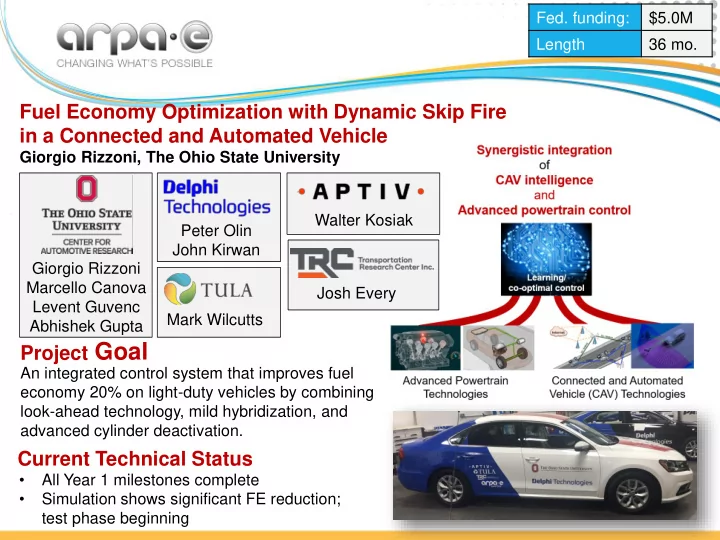

Fed. funding: $5.0M Length 36 mo. Fuel Economy Optimization with Dynamic Skip Fire in a Connected and Automated Vehicle Giorgio Rizzoni, The Ohio State University Walter Kosiak Peter Olin John Kirwan Giorgio Rizzoni Marcello Canova Josh Every Levent Guvenc Mark Wilcutts Abhishek Gupta Project Goal An integrated control system that improves fuel economy 20% on light-duty vehicles by combining look-ahead technology, mild hybridization, and advanced cylinder deactivation. Current Technical Status • All Year 1 milestones complete • Simulation shows significant FE reduction; test phase beginning
Technical accomplishments • Demonstration vehicle hardware integration complete and calibrated, including • 48V, DSF, and engine controls • ACC, Camera, Radar, V2X, and eHorizon equipment • Powertrain simulator validated; traffic integration in progress • Zero-traffic simulations show optimization algorithms to yield up to 23% fuel savings at equivalent trip travel times • eDSF Torque Smoothing: evaluated in simulation; hardware evaluation underway • Drive scenarios and vehicle test plan defined Mixed Route Conventional Driving Optimized driving
Tech-to-Market Strategy Approach to market • Key H/W technologies well-known in the industry, projected to grow 10X by 2025 • Control software will be licensed for use on existing OEM modules Anticipated first markets • Light-duty vehicles are the primary market • Electrification and automation of these vehicles expected to see explosive growth • 48V in production now; DSF in production in 2019 Approach to manufacture • Key H/W components are already production-level • Delphi has the in-house expertise to write production-level code to implement the Value Proposition controls developed for this project
Key Lessons Learned Communication is important to ensure successful collaboration • Nearly every aspect of the project impacts another, so frequent and strong communication is important • Proper communication among team members is key to integrate multi-layer controls for the P/T and CAV systems Start with simplicity and gradually add complexity • Need to implement controls in vehicle requires design methods that privilege simplicity and ease of calibration • Integration of multiple control algorithms grows complexity very quickly, making computation time a major constraint • Start with only the critical information, and track computation time as additional complexity is added The test plan is non-trivial • Fuel economy testing of automated vehicles that do not follow prescribed velocity profiles requires definition of new test procedures • Each team should spend time thinking deeply about how to obtain accurate and repeatable results
Current Challenges Integration of CAV information • Vast amount of information provided by CAV technologies will present complexity to the control structure • Addition of drivability and emissions considerations further complicates the control Mitigation Strategy • Develop the controls in stages, start with the core powertrain controls, and work outward • Identify and prioritize the incoming information with the largest impact on FE Vehicle test repeatability • FE corresponding to a driving scenario not perfectly repeatable, depends on driving style (for baseline case) and traffic/traffic lights Mitigation Strategy • Run many tests of a driving scenario to address statistical variation • Augment the test results with simulation to improve confidence and accuracy Challenges with sharing of IP and other confidential information • Powertrain optimization requires closely interfacing with engine and electric machine controls in the ECU • Some information is considered sensitive and confidential, and sharing is limited Mitigation Strategy • Collaboration and communication
Desirable Partnerships Hill/Grade Data • Most OSU testing will be conducted at the Transportation Research Center, Inc, in central Ohio, a relatively flat facility • To fully optimize the powertrain operation, OSU would like to test in or run simulations of more hilly terrain • Please let OSU know if you expect to do testing in hilly terrain and are willing to share your facilities or provide grade data that can be used in simulations Connected and Autonomous Transportation Simulator (CATS) Development • OSU has developed a python-based simulator called CATS for this project • Please let OSU know if you would like to simulate in this simulation environment so that the output of the simulator can be validated across various use cases
Connected and Automated Transportation Simulator (CATS) • Simulate V2V and V2I communication; written in Python • Easy integration with modern machine learning packages • Simulate pedestrians, blind spots, animals, rash drivers, etc.
Tools used in Year-1 Aspect Tool Transportation & Traffic CATS (Connected and Autonomous model/simulations Transportation Simulator) Machine Learning CATS (Python) Vehicle dynamic model/simulations CarSim, Matlab/Simulink Powertrain model/simulations Matlab/Simulink High fidelity map OpenStreetMap Real-time implementation strategy dSpace Microautobox
Recommend
More recommend